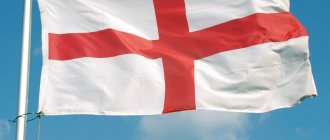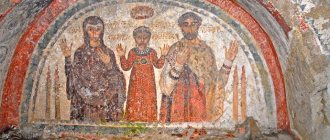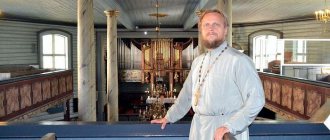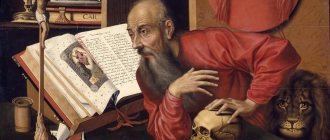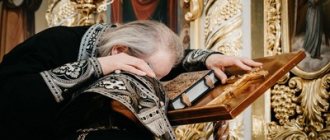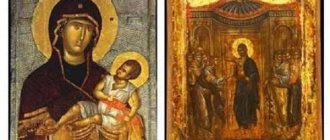Many people around the world know who Saint Patrick is. At the same time, not everyone is aware that he is not only the heavenly patron of Ireland, but also of Niger. At the same time, many people, including non-Irish people, enjoy celebrating St. Patrick's Day, which falls during Lent.
At the same time, they eat meat, since it is believed that St. Patrick turns all meat into fish on his holiday. He is revered as a saint not only by the Catholic Church, but also by the Orthodox Church, since he was canonized even before the division of the Christian Church in 1054.
Saint Patrick is a famous saint revered by almost all Christian denominations
Saint Patrick of Ireland (Patricy) (English: Saint Patrick; Latin: Sanctus Patricius, Sanctus Patricus; Irish: Naomh Padraig) is a Christian saint, patron saint of Ireland and Nigeria. Revered throughout the Christian world.
1191
this year one of the most famous temples was built - St. Patrick's Cathedral in Dublin
Such veneration is common in Catholicism, in certain Protestant churches (for example, in the Anglican, Presbyterian, Lutheran) and the Russian Orthodox Church.
Many cathedrals and churches around the world are dedicated to St. Patrick, the most famous of which is St. Patrick's Cathedral in Dublin, built in 1191.
St Patrick of Ireland, stained glass window in Auckland's Christ Cathedral. Saint Patrick is a revered saint in the Christian world. Photo: upload.wikimedia.org
Most of what we do know about the life of St. Patrick comes from his surviving writings (Confessio, Epistola ad Coroticum, Shield of St. Patrick, several others) and from poetic hymns written shortly after his death.
We know relatively little about St. Patrick for certain, but many legends that describe his miraculous deeds remember him. As the author of the Confessions, written in Latin, Saint Patrick is considered the founder of Irish literature.
Understand the Irish accent
Irish is one of the most difficult accents in the English language. Do you want to make sure? Watch the video tutorial “How to Do an Irish Accent”! When you learn to understand all the words, then any other accent is no longer scary for you.
You can learn even more about the Irish accent in our article, where we ran through the most popular accents in the UK.
Irish actress Saoirse Ronan on her native accent
Patrick of Ireland was born into a noble Roman family and was stolen from it to be sold into slavery.
Patrick (then called Maivin Succat) was born around 387, in Britain.
387
Maivin Succat, the future Saint Patrick, was born in Britain this year.
He was, as he himself writes, the grandson of the Christian priest Potitus and the son of the deacon Calpurnius, who belonged to a noble family and was a Roman decurion (official rank).
He came from the Britons, and the boy’s mother, a close relative of St. Martin of Tours, the patron saint of Gaul, came from the Franks. The mother's presumed name is Concessa. Indirect sources indicate that the saint’s family was wealthy and had a country house.
Niall Nine Hostages, Niall Neugiallach, High King of Ireland, early to mid 5th century, historical reconstruction. It is believed that Niall Nine Hostages or his relatives stole St. Patrick into slavery. Photo: pre00.deviantart.net
There is evidence that he had two sisters (one of them is Darerka of Ireland). When Patrick was about sixteen years old, he was kidnapped from his family's country estate into slavery and "with many thousands" taken to Ireland (probably to Connacht).
Patrick's kidnappers were supposedly Irish robbers led by Niall the Nine Hostages, or Picts and Scots (in 380 - 390).
The fact is that when Maximus proclaimed himself Roman emperor, he, going to Rome in 383, took with him most of the Roman troops to protect him.
Saint Patrick was born into a wealthy family and was kidnapped into slavery.
Patrick was sold into slavery in Ireland, where he remained in obedience to his master until he escaped, fulfilling the command received in revelation from God. Later, he often received such revelations from Victor, the angel of God, who often appeared to him in the form of a bird.
Before escaping, the angel told him in a night vision: “You are doing the right thing in fasting, for you will soon return to your native land,” and then, “Come and look - your ship is waiting for you.” The saint himself said that in childhood and youth he did not know the true God, but during the years of slavery he turned to him.
Mount Slemish in Northern Ireland. In its vicinity, Saint Patrick tended sheep during slavery. It is believed that Saint Patrick was enslaved by four Druids, for whom he herded sheep. Photo: disgustingmen.com
Saint Patrick was enslaved for 6 years. After the vision, he runs away and, two hundred miles later, discovers a ship being launched into the water. The ship's captain refuses to take the saint with him, since Patrick has nothing to pay, but he is eventually invited on board by one of the captain's subordinates.
Patrick accepts the offer on the condition that he does not have to comply with the customs of sailors. The ship sails to Britain or to Gaul (modern territory of France) and on the journey of the saint I expect new challenges.
Before returning to Britain, Saint Patrick was again enslaved.
Saint Patrick sailed for 3 days with his companions, after which he landed on the ground. Then he walked along it for 28 days in the desert. On the way, through his prayers, God sent them food - a herd of pigs. In addition, travelers found honey from wild bees, but Patrick, considering this food pagan, refused it.
That same night, Patrick is attacked by Satan himself, but God helps him defeat him. Next, the Confession briefly mentions the second sixty days of slavery into which Patrick fell. Apparently this time he was captured by local tribes.
Honey from wild bees. While wandering through the desert after escaping from slavery, Saint Patrick found honey from wild bees, but did not eat it, considering it pagan food. Photo: polzasostav.ru
In the text of the Confession, Patrick mentions that in total he had twelve adversities. This was the call of the Irish for the saint to return and convert them to the Faith of Christ.
Upon returning home to him in a dream, the angel Victor appears to him, carrying many letters, one of which was addressed to him and read: “Holy brother, come to us, and be with us again” (“We beg you, come and convert us ").
Having accepted the rank of bishop, Saint Patrick began to conduct missionary work in Ireland
Upon his arrival in Britain, the saint went to Gaul (present-day France), where he studied under the guidance of St. German, Bishop of Auxerre (who ordained him a deacon under the name of Patrick) and the monks of the monastery of St. Honorat on Fr. Lerins (near modern Cannes in Provence), one of the strongholds of monastic life in Gaul.
This period of the life of Patrick of Ireland is poorly covered in the sources. Soon, St. Germanus, going to Britain to fight the heresy of Pelagius (who believed that a person could achieve salvation only by his own deeds and without the grace of God), took with him St. Patrick, his disciple.
Statue of St. Patrick on the Hill of Tara. Before returning to Ireland, Saint Patrick was ordained bishop
Saint Patrick is believed to have taken episcopal orders at the monastery of Saint Martin of Tours in Auxerre, Gaul. In a letter to Coroticus, Patrick mentions that he is a bishop (episcopum me esse fateor), probably he was installed not by the pope, but by British bishops, probably Amatorex.
From his visions, St. Patrick knew that he must go to Ireland to preach. So that this can be accomplished, he goes to the then Roman bishop, Pope Celestine, who blesses this mission.
120 thousand
so many, even more Irish, were baptized by St. Patrick
The saint arrived in Ireland in 432. In the Confessions, Patrick mentions the thousands of baptisms he performed, in addition, he also talks about how he once spent two weeks in prison with his companions in shackles.
The annals of the four masters mention that he founded 600 churches (according to other sources, there were 300 churches, and the Irish who were baptized by him were more than 120,000).
St. Patrick baptizes Irish princesses. There is an Irish legend that St. Patrick baptized two daughters of the Irish king: Etne and Fedelm. Photo: upload.wikimedia.org
An Irish legend tells of two royal daughters, Etna and Fedelme, who met the saint and his companions at a lake.
The girls asked St. Patrick about God, believed and were baptized, but they wanted more: they asked for communion in order to see God faster, and then they immediately died. Both were canonized as Holy Virgins of Connacht and are commemorated on 11 January.
It is worth noting that the first bishop of Ireland, according to the Chronicle of Prosper of Aquitaine, was the Gallo-Roman Saint Palladius, so Saint Patrick cannot be called the first baptist of Ireland.
Missionary work
Upon his arrival in Ireland, Patrick initially met resistance, but he managed to spread Christian teachings far and wide, along with other missionaries, by preaching, writing, and performing countless baptisms.
Recognizing the history of pre-existing spiritual practices, nature-focused pagan rituals were also incorporated into church practices. It is believed that Patrick may have introduced the Celtic cross, which combined the traditional symbolism of sun worship with that of the Christian cross.
Throughout his missionary work, Patrick supported church officials, created councils, founded monasteries and organized Ireland into dioceses.
The place of death and burial of St. Patrick is unknown, but many legends have been written about him.
What is the faith of the Irish: from Orthodoxy to Catholicism
The place of Saint Patrick's death is not known with certainty. It is believed that he died in 493, having first received Holy Communion from the hands of his priest companion. Memorial Day is set on March 17th. The supposed places of death and burial of the saint include Downpatrick, Soule and Arm.
There is a legend that to choose a place, two untamed bulls were harnessed to the cart with the body of the saint, and the burial had to take place where they stopped.
Presumed burial place of St. Patrick. The exact date of death and burial place of St. Patrick are unknown. Photo: upload.wikimedia.org
According to legend, the angel promised the saint the fulfillment of four requests: a throne in Armagh, the opportunity to judge on Judgment Day those who read an appeal to the saint on the day of death (and the opportunity to judge all Irish), as well as mercy to the descendants of Dihu (one of the first who met Patrick during Irish missions.
The two most popular legends associated with Patrick's name are that he brought writing to Ireland and that he drove out all the snakes from there. In addition, legends and traditions often talk about competitions between St. Patrick and the Druids.
The place of death and burial of Saint Patrick is unknown.
One of the legends associated with the saint says that Patrick, using the example of a shamrock, explained to the Irish the meaning of the Unity of the Divine in the Holy Trinity.
According to another legend, the saint protected himself and eight of his companions from Loigura's revenge by singing the "Hymn of the Deer" (there is a text of this hymn attributed to Patrick), after which the avengers saw deer, not people, passing by.
According to legend, Saint Patrick performed many miracles, restoring sight to the blind, hearing to the deaf, healing lepers; resurrected the dead.
Death
The mysterious Christian hero, of course, died under unclear circumstances. Legends say that the priest, anticipating death, climbed to the top of Mount Krokh and sat there for 40 days and the same number of nights. A day before his death, Patrick confessed to the bishop, and at the same time threw a bell with prayers from the mountain to strengthen the Christian faith on Irish soil. The angels heard the calls and picked up the bell.
Stone on the supposed grave of St. Patrick
Some admirers of the saint are sure that Patrick is buried in the city of Downpatrick in the north of Ireland. Others believe that the grave should be looked for in the villages of Soule or Armagh. However, the difference in positions is explained by legend: supposedly after death, the saint’s relics were placed in a cart drawn by mad bulls, and where the animals decided to stop, there the grave would be. The first night, angels guarded the burial, and soon two certain peoples launched a massacre for the possession of Patrick’s relics. However, the war ended in a draw, because God protected the saint who had retired.
St. Patrick is revered by almost all Christian churches
Saint Patrick was already included in the first list of saints compiled by the Roman Catholic Church and did not go through the process of canonization in Rome. Moreover, veneration of the saint is most widespread in the Catholic Church.
In the Orthodox Church, local veneration was widespread in individual communities, and on March 9, 2021, by the decision of the Holy Synod of the Russian Orthodox Church, his name was included in the monthbook along with a number of ancient Christian saints of the West as “St. Patrick, Enlightener of Ireland” and the establishment of memory on March 17/30 .
St. Patrick's Cathedral in Dublin. Many churches have been built in honor of St. Patrick. Photo: upload.wikimedia.org
Patrick is especially revered as the second most important patron saint in Nigeria after the Virgin Mary. The fact is that the St. Patrick Fathers, Irish missionaries, have been actively involved in the evangelization of this country since the beginning of the 20th century. It is believed that between June 1914 and June 1930 they baptized 4,858 people there.
From the perspective of the Protestant Church of Ulster (as outlined in the 17th century by James Ussher), St. Patrick was theologically a Protestant operating independently of Rome. The veneration of the saint is carried out by believers of this denomination, especially actively in the Church of Ireland.
March 17
St. Patrick is celebrated on this day
Since the 14th century, the saint has been depicted in episcopal robes (sometimes including a shepherd’s crook), until the 17th century - beardless, and later - with a beard. Often depicted with a shamrock in his hand, he may be depicted trampling a snake with his foot. Additionally, one of his hands may be raised in blessing.
There are Orthodox icons depicting the saint, including icons painted in the Eastern tradition, kept in Catholic cathedrals.
[edit] Summary
Fail. The parade on the chipboard is some kind of incomprehensible shit, consisting of strange personalities in a variety of carnival and not so carnival costumes.
Wine is sometimes observed in taverns, where people flock to get drunk on Guinness and other alcoholic products of the green island. If, God forbid, they also organize a concert in the tavern, then that’s it, fucked up kids, there will be no end to the assholes there. In the absence of a concert, it turns out to be a decent drinking party with competitions and cheerful girls, what a WIN!
St. Patrick's Day is celebrated all over the world
St. Patrick's Day is a cultural and religious holiday celebrated annually on March 17, the day of the death of Ireland's patron saint, St. Patrick (circa 385 - 461 AD). St. Patrick's Day was proclaimed a Christian holiday at the beginning of the 17th century and is celebrated by the Catholic Church.
Russian Orthodox Church (venerated on March 30; included in the month of March 9, 2021), individual Protestant churches (Anglican, Lutheran and especially the Church of Ireland). It symbolizes the adoption of Christianity in Ireland.
Celebrating St. Patrick's Day in Cork, Ireland. St. Patrick's Day is usually associated with parades and processions in his honor. Photo: upload.wikimedia.org
St. Patrick's Day celebrations typically include parades and festivals, ceilidh dancing, and wearing green or shamrocks. Christians also attend church services on this day.
On this day, restrictions associated with fasting are relaxed and alcohol consumption is permitted. St. Patrick's Day is a public holiday in Northern Ireland, Montserrat and the Canadian province of Newfoundland and Labrador.
St. Patrick's Day is also widely celebrated by the Irish diaspora around the world, especially in the UK, Canada, USA, Argentina, Australia and New Zealand.
March 17, 2017
On this day, St. Patrick's Day was officially celebrated for the first time in Russia.
In 2021, the Russian Orthodox Church decided to include in the monthly calendar some “ancient saints who labored in Western countries” before the great schism, including “St. Patrick, the Enlightener of Ireland,” whose memorial day will be celebrated on March 17 (30).
By leaving a comment, you accept the user agreement
